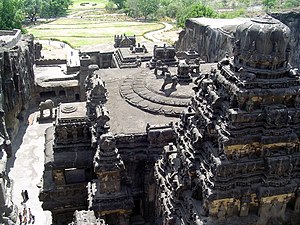There are over 100 caves at the site, all excavated from the basalt cliffs in the Charanandri Hills, 34 of which are open to public.[3] These consist of 12 Buddhist (caves 1–12), 17 Hindu (caves 13–29) and 5 Jain (caves 30–34) caves,[6][7] each group representing deities and mythologies prevalent in the 1st millennium CE, as well as monasteries of each respective religion.[6] They were built close to one another and illustrate the religious harmony that existed in ancient India.[2][8] All of the Ellora monuments were built during the Rashtrakuta dynasty, which constructed part of the Hindu and Buddhist caves, and the Yadava dynasty, which constructed a number of the Jain caves. Funding for the construction of the monuments was provided by royals, traders and the wealthy of the region.[3][9]
Although the caves served as monasteries, temples and a rest stop for pilgrims,[7] the site's location on an ancient South Asian trade route also made it an important commercial centre in the Deccan region.[10] It is 29 kilometres (18 miles) north-west of Aurangabad, and about 300 kilometres (190 miles) east-northeast of Mumbai. Today, the Ellora Caves, along with the nearby Ajanta Caves, are a major tourist attraction in the Marathwada region of Maharashtra and a protected monument under the Archaeological Survey of India [ASI].[11] Wikipedia









































































